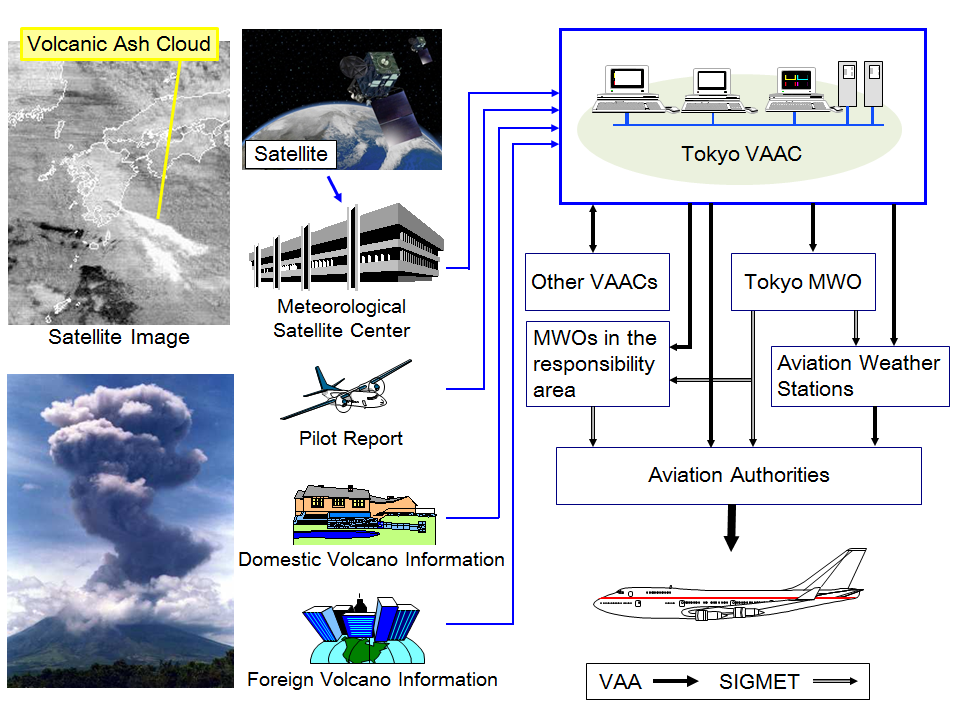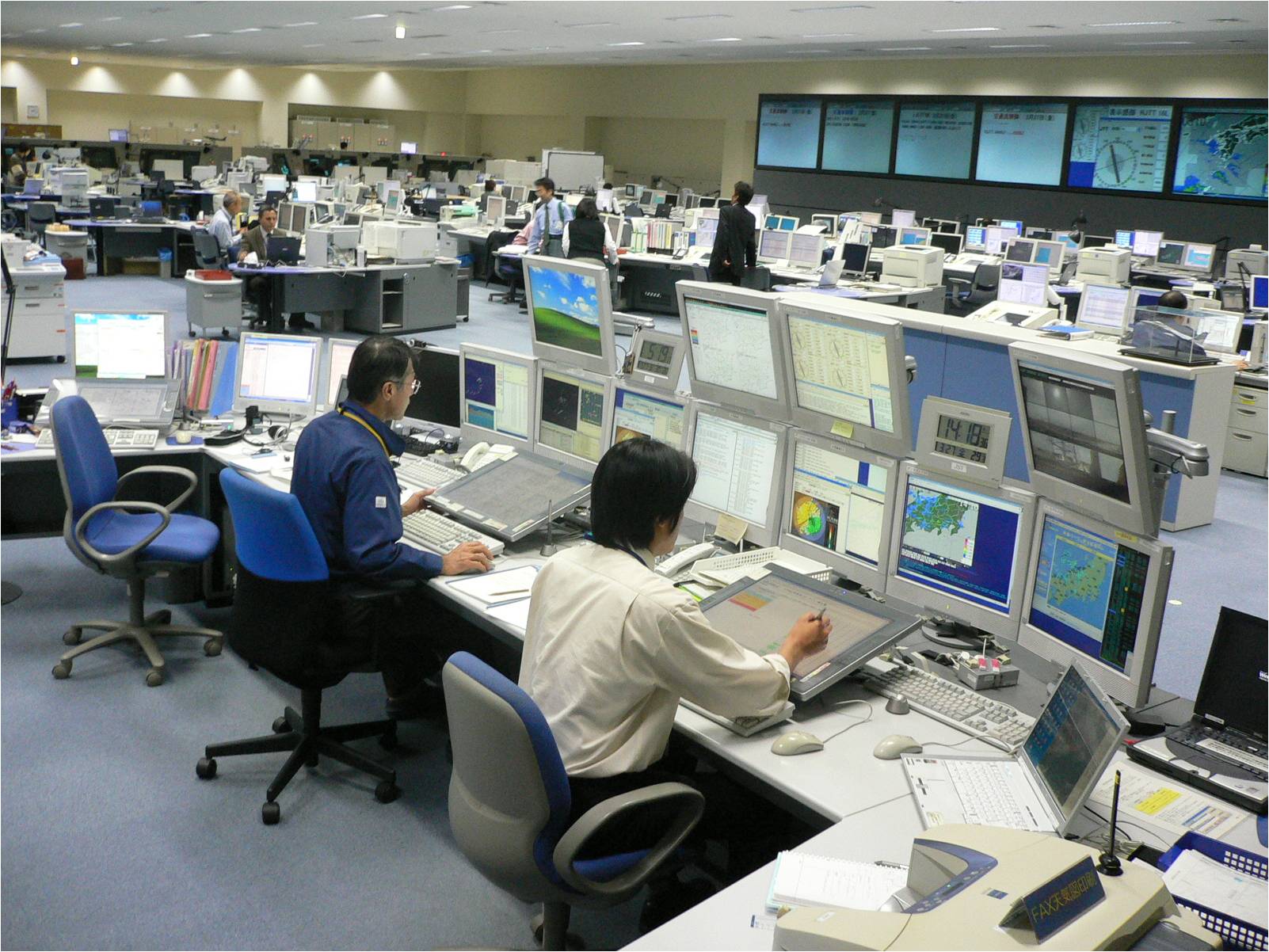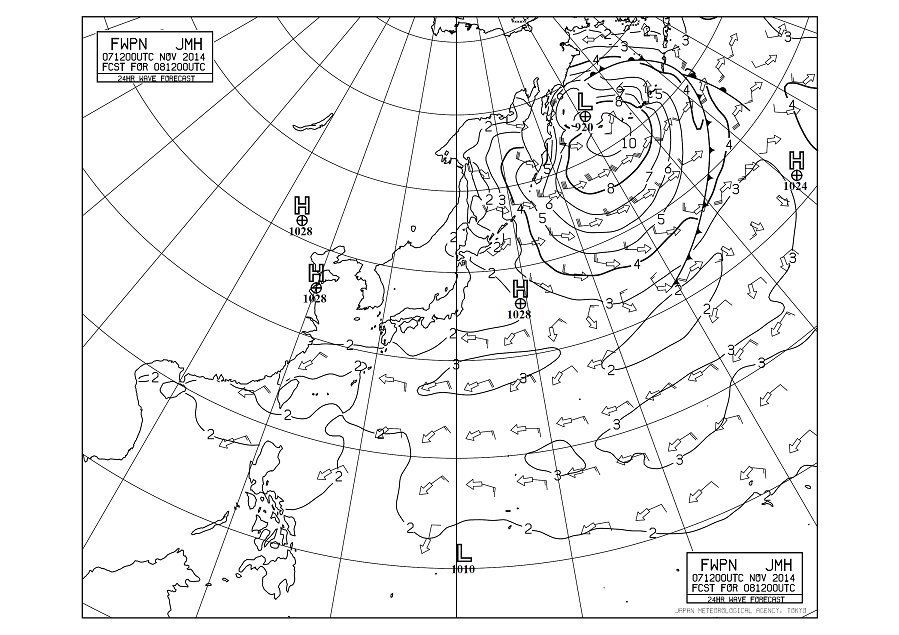Aviation/Marine Weather Services
To secure the safety, regularity and efficiency of domestic and international aviation operations in Japan, JMA provides aviation weather services for airlines and the air traffic control authority - the Civil Aviation Bureau of the Ministry of Land, Infrastructure, Transport and Tourism (MLIT) - and National Meteorological Services around the world.
Aeronautical Meteorological Observations
Aviation weather offices observe not only basic meteorological elements but also specific ones that are critical for aviation operations, such as runway visual range and cloud ceiling height. Particular attention is paid to severe weather conditions that seriously affect aviation operations.
Lightning, for example, is continuously observed using a monitoring system composed of lightning detectors installed at 30 airports across the country.
Rainfall is monitored by Doppler radars at nine airports. These units are also capable of observing three-dimensional wind fields to detect low-level wind shear, which is often hazardous to aircraft during takeoff and landing in conditions of precipitation. When there is no precipitation, three-dimensional wind fields are observed using Doppler lidars at three airports.
Information on wind shear is passed on to pilots through the air traffic control authority in real time so that they can take immediate action to evade hazardous conditions.
Aviation Weather Forecasts and Warnings
JMA provides forecasts, warnings and bulletins on the weather conditions at airports as well as information on en-route weather conditions for cruising aircraft.
At 38 major airports, aerodrome forecasts for up to 30 hours ahead are issued every 6 hours. If severe weather is expected, "aerodrome meteorological information" and/or "aerodrome warnings" are also issued.
SIGMET information is issued to provide advice on weather phenomena that can be hazardous to aircraft in flight (such as turbulence and thunderstorms) to the Fukuoka Flight Information Region (FIR) for international flights.
Volcanic Ash Advisory
Clouds of volcanic ash ejected by active volcanoes contain hazardous materials, which can seriously hinder airplane engine operation. In its role as the Tokyo Volcanic Ash Advisory Center (VAAC) as designated by the International Civil Aviation Organization (ICAO) in cooperation with WMO, JMA provides Volcanic Ash Advisories (VAAs) detailing the current status and forecasts of volcanic ash clouds for East Asia, the Northwest Pacific region and part of Arctic Circle.
Other Aviation Meteorological Services
Tokyo VOLMET broadcast
For aircraft in flight in the Pacific region, JMA disseminates weather reports for six major international airports in Japan as well as for Incheon International Airport (Republic of Korea) via Tokyo VOLMET, a short-wave radio broadcasting service.
Tokyo OPMET Data Bank
The Tokyo Operational Meteorological (OPMET) Data Bank collects and archives aviation weather reports from the Asia-Pacific region. The resource allows aeronautical users to access stored reports through the Aeronautical Fixed Telecommunications Network (AFTN) - a dedicated aeronautical communications network connecting National Aviation Bureaus and National Meteorological Services.
Communication of Aviation-related Meteorological Information
Observational meteorological reports and aerodrome forecasts issued by Aviation Weather Stations (AWSs) along with various aeronautical weather charts produced by JMA Headquarters are distributed to airport traffic control units of the Civil Aviation Bureau (CAB) and airlines. The aerodrome meteorological information network is utilized for this dissemination. Observational reports and aerodrome forecasts are also provided to aircraft in flight through Tokyo VOLMET broadcasting and air-ground CAB communications. Meanwhile, information on significant weather conditions encountered by pilots in flight (turbulence in particular) is transmitted to JMA via air traffic controllers and relayed to airlines. Aeronautical meteorological bulletins are also exchanged internationally through the AFTN.
Air Traffic Meteorology Center
JMA's Air Traffic Meteorology Center (ATMetC), established in Oct. 2005, supports the Air Traffic Management Center (ATMC) of the Japan Civil Aviation Bureau (JCAB). JCAB's ATMC service is designed to ensure the smooth and flexible use of airspace and promote its efficient use in order to contribute to the systematization of flight routes in the Fukuoka Flight Information Region. Significant weather events affect the air traffic network, so ATMetC provides the timely meteorological information needed by ATMC controllers and related parties. ATMetC staff support ATMC's operations by working together in the same operation room, thereby contributing to the safe and smooth operation of aviation traffic in Japan.
The ATMetC Tokyo Metropolitan Area Team (TMAT) at Tokyo International Airport provides detailed weather forecasts for airspace and airports in the metropolis. The ATMetC New Chitose Area Team (NCAT) at New Chitose Airport also provides forecasts for areas around the facility and the surrounding air space.
Marine Forecasts and Warnings
Marine meteorological forecasts and warnings such as those for gales, storms, typhoons and fog are provided for the safety and efficiency of shipping, fisheries and other offshore activities. JMA is responsible for preparing and issuing warnings and weather and sea bulletins through the international SafetyNET service under the framework of the GMDSS (Global Marine Distress and Safety System) for the high seas mainly in the western North Pacific. Detailed marine safety information is provided for the sea areas around Japan through the international NAVTEX service. Graphical information (including surface weather maps and ocean wave charts) is broadcast through JMH (by radiofacsimile) for the western North Pacific. In the winter season, sea ice forecasts and bulletins are also issued for the Sea of Okhotsk.



